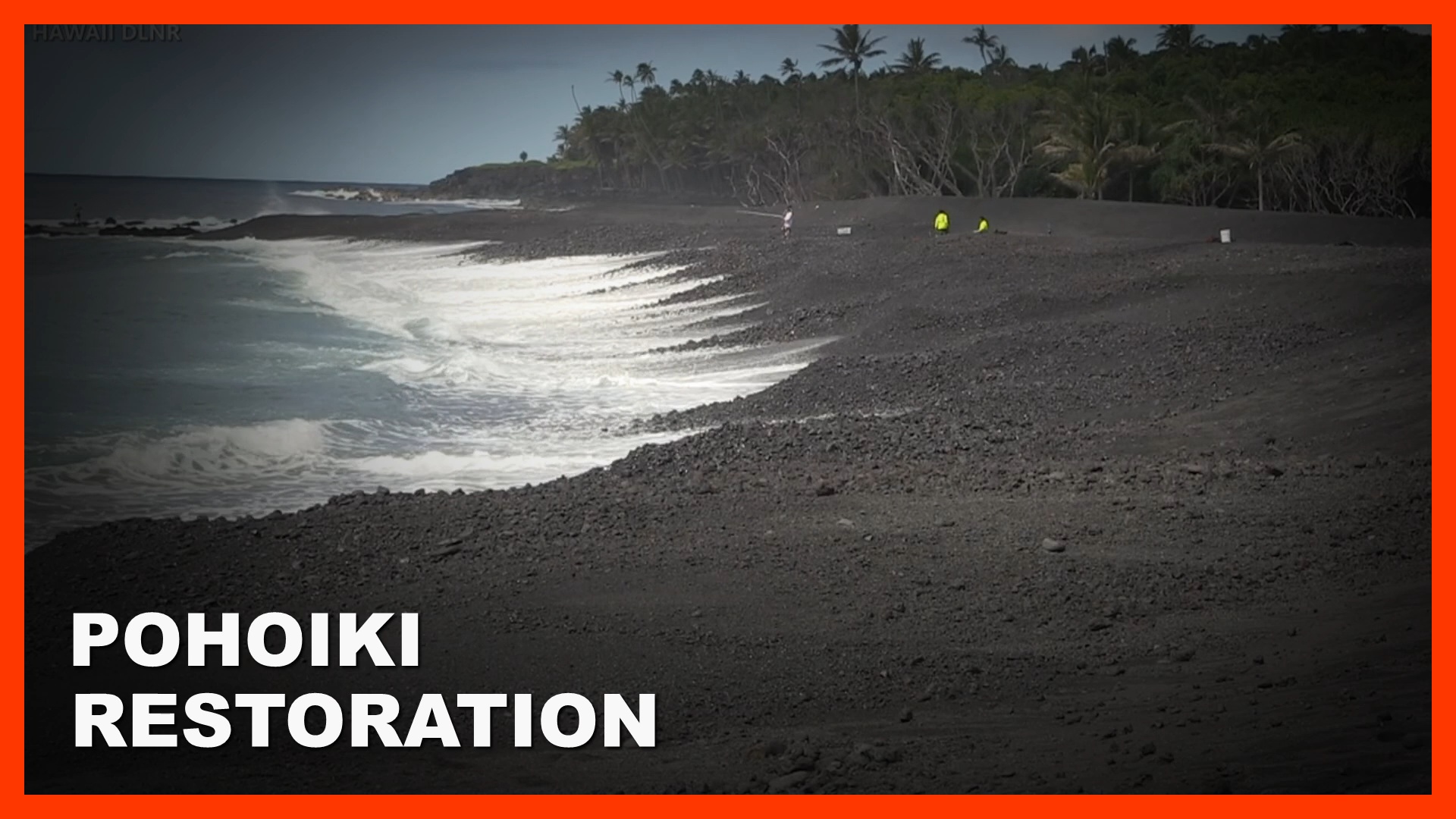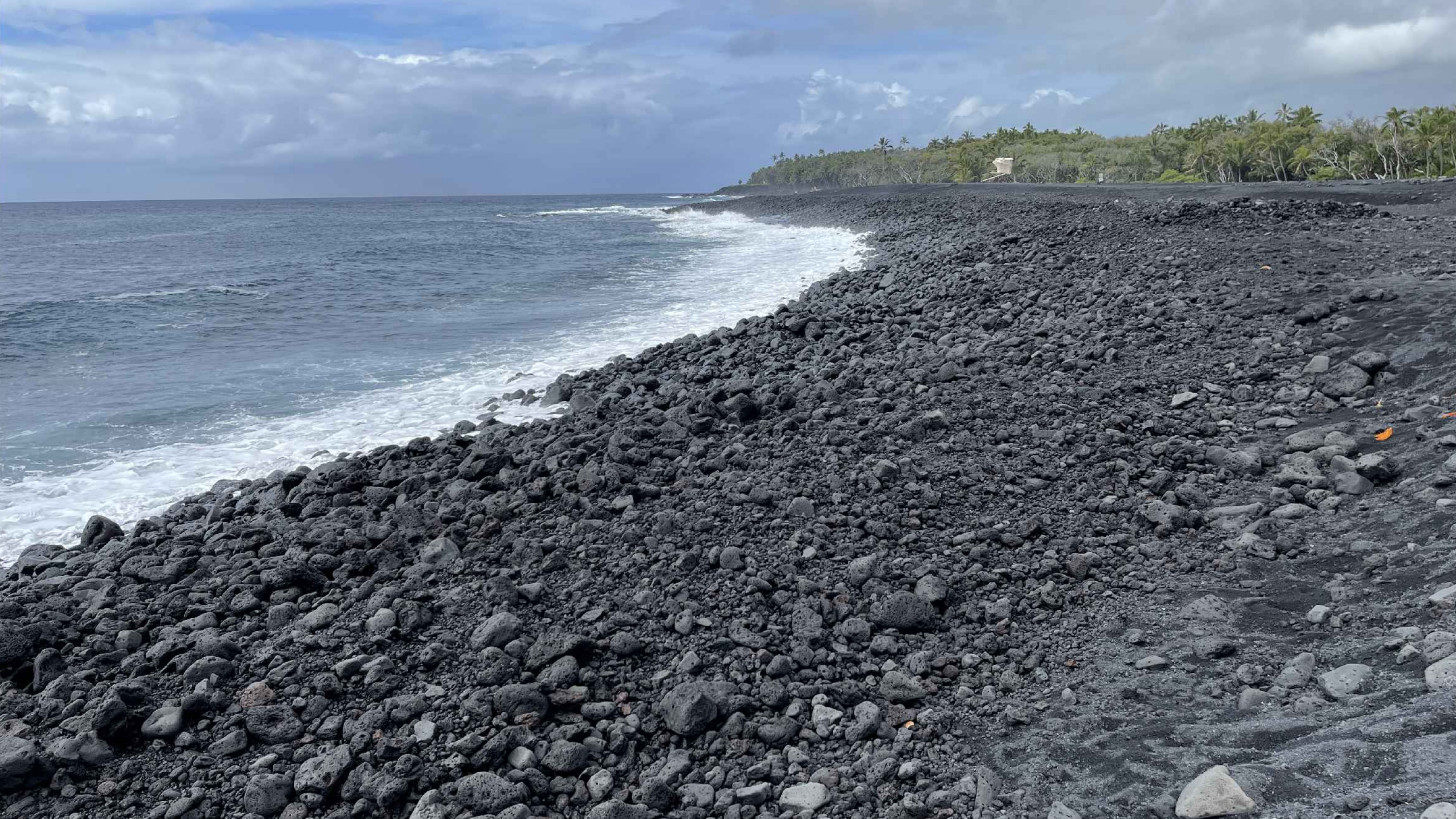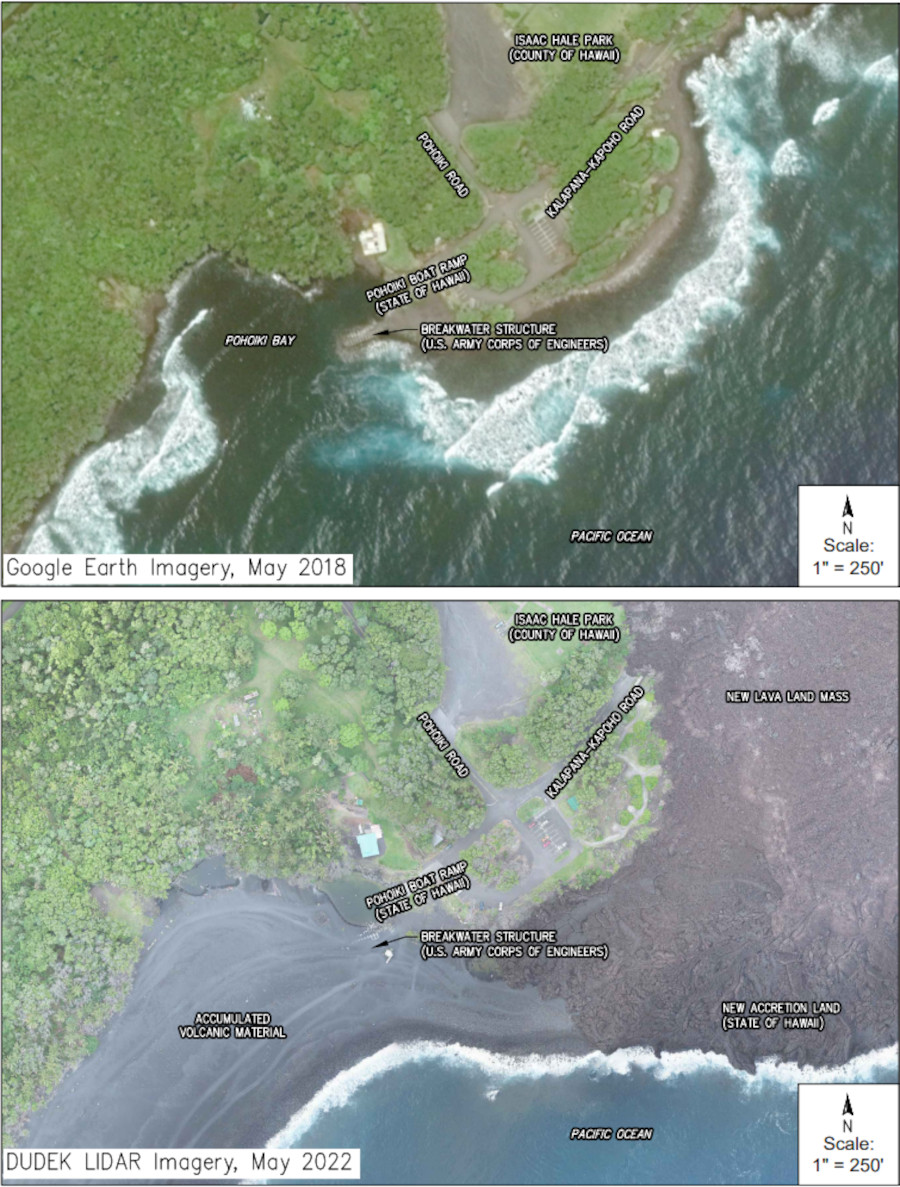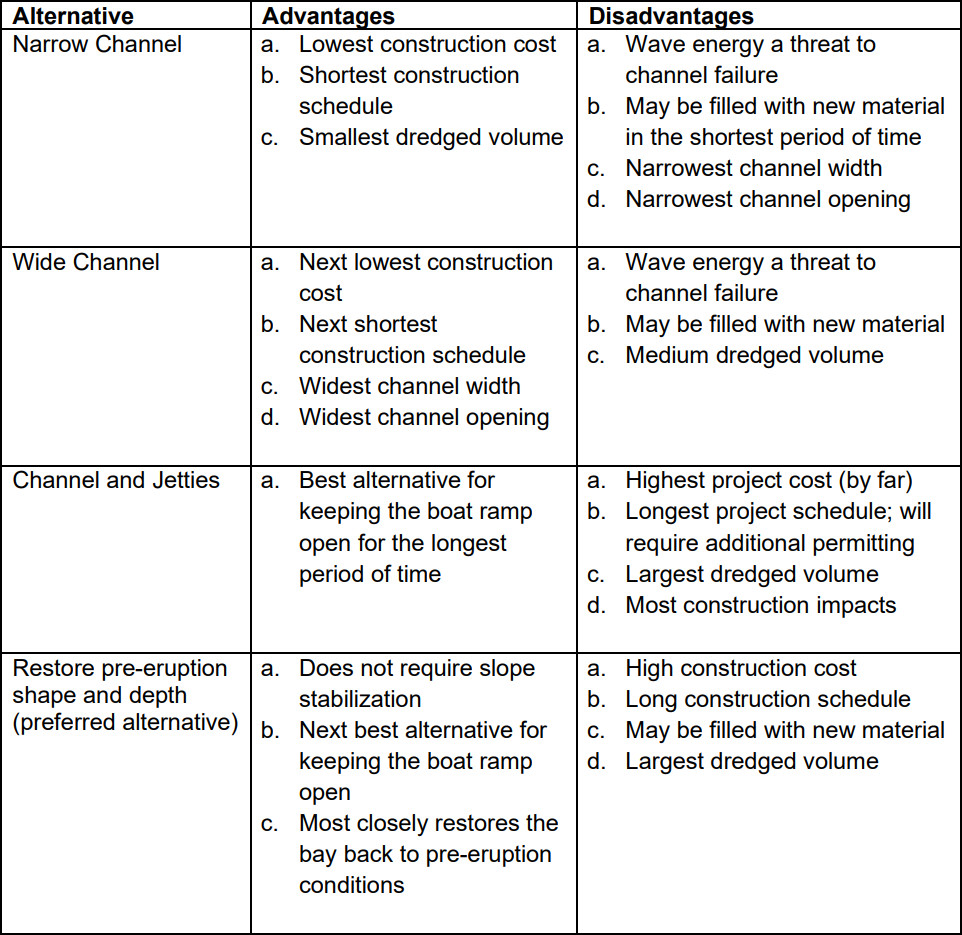This story appears in the above BIVN Hawaiʻi Update. The video will jump to the associated story when played. (A synthesized voice was utilized in the narration for this story)
(BIVN) – A Draft Environmental Assessment examining a plan restore Pohoiki Bay “to a shape and depth that resembles pre-eruption conditions to the extent possible” is now online.
The Pohoiki Boat Ramp Dredging of Volcanic Debris Draft EA was published in The Environmental Notice for April 23. The Hawaiʻi Department of Land and Natural Resources, with the help of The Limtiaco Consulting Group, is proposing to restore navigational access to the landlocked boat ramp by removing accumulated material from Pohoiki Bay through excavation and dredging. The volcanic material “would be placed in areas of new lava or new beach that are away from the ocean”, the document says.
From the Introduction and Background of the Draft EA:
In 2018, lava from the Kīlauea Volcano, Lower East Rift Zone eruption flowed across vast areas of the lower Puna district (South of Hilo, North of Ka‘ū) and reached the southeast coastline of Hawaiʻi Island. On May 24, 2018, three lava flows reached the ocean between Pohoiki Bay and MacKenzie State Park, which is about 2.1 miles to the southwest. Lava entered the ocean approximately 0.9 miles northeast from Pohoiki Bay at ʻAhalanui Beach Park on July, 12, 2018 and advanced to approximately 230 feet southeast of the Pohoiki Boat Ramp facility by August 6, 2018. Fresh black sand that was created as molten lava was chilled and shattered by the surf was transported by wave currents to Pohoiki Bay. On August 13, 2018, the boat ramp was blocked by a sandbar of accumulated volcanic material in Pohoiki Bay.
The existing boat ramp area at Pohoiki Bay was spared from lava inundation but nearby terrain to the east has been altered including a large portion of Isaac Hale Beach Park; the lava flow formed a new land mass consisting of a new lava layer on existing land and accretion land consisting of entirely new land that extends into the Pacific Ocean. Constant wave activity at the accretion land and ocean interface continuously produces sand, rock, and cobbles. The boat ramp and a breakwater structure are located at Pohoiki Bay, which was approximately 1,000 feet wide at the mouth and extended inland approximately 450 feet. Loose material transported along the coast by prevailing wave direction and ocean currents has accumulated in Pohoiki Bay since 2018, such that the undamaged boat ramp facility remains landlocked.
An exploratory boring at Pohoiki Bay was taken in May 2022. The boring extended to a depth of 27 feet and revealed a beach deposit surface layer about 18 feet thick that is underlain by a shallow marine deposit extending to a depth of roughly 20.5 feet. A clinker deposit approximately 4 feet thick is below the shallow marine deposit. The underlying layer, extending to the maximum depth explored, consists of basalt rock. The likely composition of the accumulated material in Pohoiki Bay includes sand, gravel, some cobbles and occasional boulders. A more detailed description of the exploratory findings is provided in Section 2.1.2. Soils and Topography. Accumulated volcanic debris consisting of sand, rock and cobble currently covers an area of approximately 11.6 acres and blocks navigational access from the Pohoiki Boat Ramp facility to the Pacific Ocean (see Figures 1 through 3). The Puna coastline is almost entirely rocky sea cliffs, with deep water close to shore and relatively high nearshore ground elevations. Other than what used to be Pohoiki Bay, there are no shallow water embayments (a recess along a coastline) or significant headlands (such as bluffs or mounds) to provide natural wave protection. The coast is directly exposed to the persistent and prevailing trade winds generated by the seas, and summer season south swell. Tropical storms and hurricanes passing south of the island generate large waves that can batter the coast.
Community members most impacted by the inoperable boat ramp have been adamant about the need to re-open the Pohoiki Boat Ramp facility, which is owned and maintained by the Department of Land and Natural Resources, Division of Boating and Ocean Recreation (DLNR – DOBOR). The existing Pohoiki Boat Ramp facility has an 18-foot-wide single-lane ramp. The U.S. Army Corps of Engineers (USACE) is responsible for maintaining the 90-foot long breakwater structure that was completed in 1979. DOBOR’s boat ramp is undamaged and USACE’s breakwater structure is intact but partially covered by accumulated volcanic debris.
DOBOR registers small vessels and is responsible for the management and administration of statewide ocean recreation and coastal area programs pertaining to the ocean waters and navigable streams of the State of Hawaiʻi. DOBOR’s jurisdiction excludes commercial harbors. The areas and facilities that fall within DOBOR’s jurisdiction include 21 small boat harbors, 54 launching ramps, 13 offshore mooring areas, 10 designated ocean water areas, 108 designated ocean recreation management areas, associated aids to navigation throughout the State, and beaches encumbered with easements in favor of the public.
The project proposed by DOBOR will reestablish pre-eruption navigational access to the Pacific Ocean and return the Pohoiki Boat Ramp facility to productive use. The proposed project involves dredging the accumulated volcanic debris in Pohoiki Bay to restore the bay to a shape and depth that resembles pre-eruption conditions to the extent possible (see Figures 4). Dredged volcanic debris would be distributed on newly formed lava land and away from the Pacific Ocean. Existing debris would be removed from Pohoiki Bay through excavation and dredging before being transported via trucks to nearby locations identified for volcanic material placement. Heavy equipment utilized for the project will avoid traveling and working on or near the existing breakwater structure. Settled sand and cobbles on the breakwater may be manually removed with the use of hand tools to ensure that the breakwater structure is not damaged.
State of Hawaiʻi lands and funds will be utilized for DOBOR’s project, which will partially occur within a conservation district; therefore, the preparation of an Environmental Assessment (EA) pursuant to Chapter 343, Hawaiʻi Revised Statutes (HRS) and associated Title 11, Chapter 200.1, Hawaiʻi Administrative Rules (HAR) is required. This EA was prepared to examine potential project impacts and to provide for public participation as required and defined in the statutes. The project will occur within the Special Management Area (SMA). The Federal Emergency Management Agency (FEMA) may also award federal funding as part of its Public Assistance program, which allows communities to respond and recover from major disasters or emergencies. The Hawaiʻi Emergency Management Agency (HI-EMA) would work with FEMA and conduct final reviews of FEMA-approved projects. FEMA would reimburse the State of Hawaiʻi up to a percentage of eligible project costs.
About 100 pages into the document, the alternatives are compared using a chart. “There is expressed opposition from community members to locations beyond Pohoiki Bay,” the Draft EA reads. “No action is also not included since it does not achieve the stated objective of restoring navigational access.”
A statutory 30-day public review and comment period has begun. Comments are due by May 23, 2023.





by Big Island Video News9:22 pm
on at
STORY SUMMARY
PUNA, Hawaiʻi - Public comments are being accepted on a plan to dredge the accumulated volcanic debris and restore access to the Pohoiki Boat Ramp.